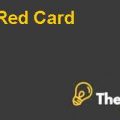Teuer Furniture (A): Discounted Cash Flow Valuation Case Solution
Introduction
Teuer Furniture, a prominent chain of upscale home furnishing showrooms in the United States, embarked on a strategic evaluation led by its Chief Financial Officer, Jennifer Jerabek, and her adept finance team. This evaluation delved into the intricacies of financial forecasting and capital investment to determine the company's valuation.
Guided by an innovative approach to capital management, Teuer's investment in working capital for enhanced customer experiences emerged as a key factor in its success. The company's prudent inventory practices, efficient accounts receivable strategies, and strategic lease agreements aligned operational tactics with financial sustainability.
Balancing working capital optimization with capital expenditure planning underscored Teuer's commitment to both customer satisfaction and financial growth. Pro forma financial statements were meticulously constructed, paving the way for discounted cash flow valuation.
This case offers a comprehensive financial analysis, examining historical data, forecasting, and borrowing scenarios through Adjusted Present Value (APV) calculations, providing crucial insights into the implications of borrowing decisions on Teuer Furniture's valuation and financial stability.
Problem Statement
The challenge before Teuer Furniture lies in accurately valuing its business amidst intricate financial dynamics. CFO Jennifer Jerabek and her team are tasked with harmonizing historical growth, showroom costs, and working capital investments to ascertain a precise valuation.
This entails aligning strategic projections with economic uncertainties to gauge Teuer's true potential value. The case focuses on identifying the optimal borrowing strategy for enhancing financial stability and value.
Situational Analysis
Crucial Business Juncture
Teuer Furniture, an upscale home furnishing showroom chain, stands at a crucial juncture in its business trajectory. The company's history is marked by remarkable growth, with its sales soaring from its inception in 2003 to a peak in 2012. Teuer's strategic success rests on its unique model of delivering high-quality furniture to upper-income individuals through a high-touch shopping experience. Operating in second-tier cities, Teuer strategically positions itself to cater to this discerning clientele.
A key factor in Teuer's approach is its strong focus on customer service, manifested in its convenient shopping experience and well-trained sales associates. Despite economic turbulence, Teuer managed to weather the storm of the 2008 recession and maintain profitability, thanks to its efficient operational strategies and customer-centric approach.
Challenges and Valuation
The company's financial stability allowed it to explore growth opportunities and establish a network of showrooms. This expansion strategy, however, brought complexities related to forecasting, showroom costs, and working capital management.
Teuer's intricate financial ecosystem requires a meticulous approach to valuation, taking into account showroom maturation, economic trends, and future growth prospects. CFO Jennifer Jerabek and her finance team must unravel these complexities to accurately determine the company's valuation and make informed decisions for its future.
Alternatives
After analyzing the case there are two alternatives to provide Teuer Furniture with distinct borrowing strategies that balance immediate value enhancement against varying levels of risk. Each option considers different debt amounts, repayment structures, and their respective impacts on the cost of equity. The company must evaluate the trade-offs between securing funds for growth, maintaining financial stability, and meeting investors' preferences when deciding on the most suitable alternative.
Scenario One (Fixed Repayment Borrowing)
This scenario offers the advantage of a predictable repayment schedule and minimal default risk, given Teuer's strong financial position. The fixed repayment plan over five years helps maintain financial stability and reduces uncertainty for investors. The 10 basis points increase in the cost of equity is relatively modest and may not significantly impact the company's overall valuation. However, this approach might limit the firm's flexibility to invest in additional growth opportunities during the repayment period.
Scenario Two (Gradually Increasing Debt)
While this scenario provides Teuer Furniture with a larger initial borrowing capacity, it introduces higher risk due to ongoing debt accumulation. The incremental increase in debt aligns with investors' preference for leveraging the firm, but the 20 basis points rise in the cost of equity reflects the increased financial risk. This approach allows more flexibility for the company to invest in growth initiatives in the short term, but the higher cost of equity could impact its valuation and profitability over time............
This is just a sample partial case solution. Please place the order on the website to order your own originally done case solution.













